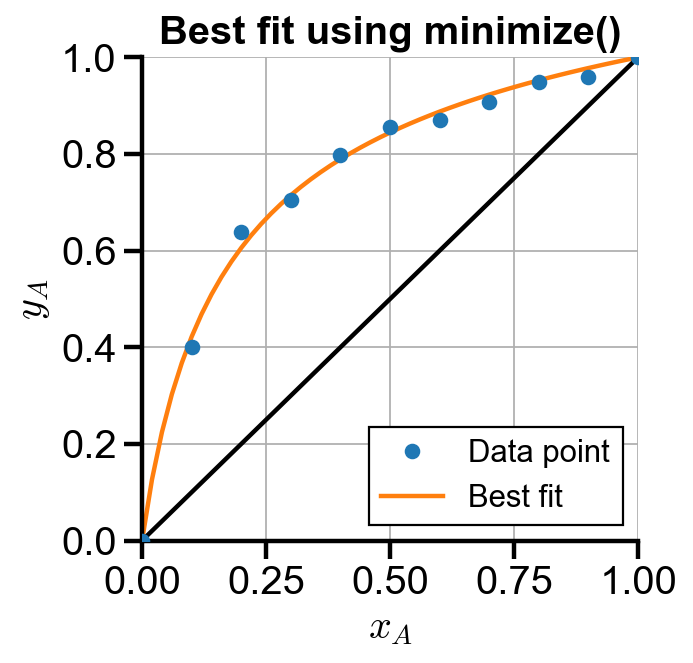Determining Antoine’s Coefficients#
Teng-Jui Lin
Content adapted from UW CHEME 375, Chemical Engineering Computer Skills, in Spring 2021.
Python skills and numerical methods
Solving nonlinear systems
Control flow
Curve fitting
ChemE applications
Determine Antoine’s coefficients
x/y diagrams
Txy diagrams
Determine Antoine’s coefficients#
Problem Statement. Compounds A and B with unknown Antoine’s coefficients are in binary vapor liquid equilibrium at a pressure of 1 atm. The experimental data are
x_A = [0, 0.1, ..., 1.0]y_A = [0, 0.401, 0.639, 0.704, 0.798, 0.855, 0.871, 0.907, 0.948, 0.959, 1.0]
(a) Assuming ideal gas and solution behavior, determine the Antoine’s coefficients of A and B using the form
where
Compound |
A |
B |
C |
|---|---|---|---|
A |
14 |
2800 |
250 |
B |
15 |
3000 |
200 |
(b) Generate an x/y diagram and a Txy diagram for the methanol-ethanol system.
Solution. Assuming ideal behavior, Raoult’s law states that the partial pressure of one component is equal to the vapor pressure of the component times its liquid mole fraction
where the vapor pressure can be determined by the given Antoine’s equation form
We use given
Known values#
Units of values in Antoine’s equation
P [=] kPa
T [=] deg C
Known liquid and vapor composition
although given experimental values, here we’re finding theoretical values
Known pressure
Fitting parameters (find by minimize())#
Antoine’s coefficients of A and B:
Given initial guesses
Compound |
A |
B |
C |
|---|---|---|---|
A |
14 |
2800 |
250 |
B |
15 |
3000 |
200 |
Unknown variables (find by fsolve())#
Composition of liquid phase:
Composition of vapor phase:
Temperature:
Governing equations#
The raw equations are:
Raoult’s law and Antoine’s equation
conservation of mass (mole, since nonreactive)
Convert all the equations so they’re in the general form of
Raoult’s law and Antoine’s equation
conservation of mass
We can now solve the four nonlinear equations with respect to the four unknown variables given the known values at each
Implementation#
In this approach, we use scipy.optimize.fsolve() to solve the nonlinear system directly at each
We then use scipy.optimize.minimize() to find the set of Antoine’s coefficients that gives the lowest SSR.
import numpy as np
from scipy.optimize import fsolve
from scipy.optimize import fmin
from scipy.optimize import minimize
import matplotlib.pyplot as plt
def system(X, params):
'''System of nonlinear equations'''
# X -> unknown variables
# params -> known values
xb, ya, yb, T = X
xa, P, Aa, Ba, Ca, Ab, Bb, Cb = params
# set up system of equations
eqns = np.array([
ya*P - xa*np.e**(Aa - Ba/(Ca + T)),
yb*P - xb*np.e**(Ab - Bb/(Cb + T)),
1 - ya - yb,
1 - xa - xb
])
return eqns
# define given experimental data
xa_exp = np.arange(0, 1.1, 0.1)
ya_exp = np.array([0, 0.401, 0.639, 0.704, 0.798, 0.855, 0.871, 0.907, 0.948, 0.959, 1.0])
# initial guess of system
X0 = [0.5, 0.5, 0.5, 50]
# given initial guesses of Antoine's coeff
antoine_coeffs_0 = np.array([15, 2500, 200, 15, 3000, 200])
P = 1 * 101.325 # atm -> kPa
def VLE(system, X0, xa, P, antoine_coeffs):
'''
Iterate to find the theoretical yb (along with other var)
for each guess of Antoines coefficients
'''
xa_len = len(xa)
xb = np.zeros(xa_len)
ya = np.zeros(xa_len)
yb = np.zeros(xa_len)
T = np.zeros(xa_len)
for i in range(xa_len):
params = [xa[i], P, *antoine_coeffs]
xb[i], ya[i], yb[i], T[i] = fsolve(system, X0, params)
return xb, ya, yb, T
def SSR(antoine_coeffs, system, X0, xa, P):
ya = VLE(system, X0, xa, P, antoine_coeffs)[1]
ssr = np.sum((ya - ya_exp)**2)
return ssr
xa = np.arange(0, 1.02, 0.02)
res = minimize(SSR, antoine_coeffs_0, args=(system, X0, xa_exp, P))
antoine_coeffs_minimize = res.x
antoine_coeffs_minimize
array([ 16.18438949, 2501.42874749, 172.76695042, 14.12238484,
2998.80931298, 227.23357737])
xb_minimize, ya_minimize, yb_minimize, T_minimize = VLE(system, X0, xa, P, antoine_coeffs_minimize)
Using minimize(), we found the Antoine’s coefficients are as follows:
Compound |
A |
B |
C |
|---|---|---|---|
A |
16.18439 |
2501.429 |
172.7670 |
B |
14.12238 |
2998.809 |
227.2336 |
which are close to our initial guesses.
Note. If fmin() is used instead of minimize(), it may not give good Antoine’s coefficients, even though their VLE diagrams may look similar. fmin() is sensitive to initial guesses. The following demonstrates that one should NOT use fmin() in this case:
# do NOT use fmin (demo)
xa = np.arange(0, 1.02, 0.02)
antoine_coeffs_fmin = fmin(SSR, antoine_coeffs_0, args=(system, X0, xa_exp, P), maxiter=1e5, maxfun=1e5)
antoine_coeffs_fmin
C:\Softwares\Anaconda\Anaconda\lib\site-packages\scipy\optimize\minpack.py:162: RuntimeWarning: The iteration is not making good progress, as measured by the
improvement from the last ten iterations.
warnings.warn(msg, RuntimeWarning)
C:\Softwares\Anaconda\Anaconda\lib\site-packages\ipykernel_launcher.py:9: RuntimeWarning: overflow encountered in double_scalars
if __name__ == '__main__':
C:\Softwares\Anaconda\Anaconda\lib\site-packages\ipykernel_launcher.py:9: RuntimeWarning: invalid value encountered in double_scalars
if __name__ == '__main__':
Optimization terminated successfully.
Current function value: 0.002733
Iterations: 567
Function evaluations: 1007
array([ 15.28095414, 3393.4707803 , 231.70952711, 13.79716241,
4567.9164073 , 338.53386793])
The fmin() function raises warnings that the tolerance has not been reached, having an SSR of 0.0027. The returned Antoine’s coefficients are far from our initial guesses, therefore the result should not be used.
VLE Diagrams#
# plot settings
%config InlineBackend.figure_format = 'retina'
%matplotlib inline
plt.rcParams.update({
'font.family': 'Arial', # Times New Roman, Calibri
'font.weight': 'normal',
'mathtext.fontset': 'cm',
'font.size': 18,
'lines.linewidth': 2,
'axes.linewidth': 2,
'axes.spines.top': False,
'axes.spines.right': False,
'axes.titleweight': 'bold',
'axes.titlesize': 18,
'axes.labelweight': 'bold',
'xtick.major.size': 8,
'xtick.major.width': 2,
'ytick.major.size': 8,
'ytick.major.width': 2,
'figure.dpi': 80,
'legend.framealpha': 1,
'legend.edgecolor': 'black',
'legend.fancybox': False,
'legend.fontsize': 14
})
# x/y diagram
fig, ax = plt.subplots(figsize=(4, 4))
ax.plot(xa_exp, ya_exp, 'o', label='Data point', zorder=3)
ax.plot(xa, ya_minimize, label='Best fit')
ax.plot([0, 1], [0, 1], color='black')
ax.set_xlabel('$x_A$')
ax.set_ylabel('$y_A$')
ax.set_title('Best fit using minimize()')
ax.set_xlim(0, 1)
ax.set_ylim(0, 1)
ax.legend()
ax.grid(True)

# main Txy diagram
fig, ax = plt.subplots(figsize=(4, 4))
ax.plot(xa, T_minimize, color='black')
ax.plot(ya_minimize, T_minimize, color='black')
ax.set_xlabel('$x_A, y_A$')
ax.set_ylabel('$T \ [^\circ C]$')
ax.set_title('VLE Txy diagram')
ax.set_xlim(0, 1)
ymin = 40
ymax = 90
ax.set_ylim(ymin, ymax)
ax.grid(True)
# colored phase regions
ax.fill_between(xa, ymin, T_minimize, color='blue', alpha=0.1)
ax.fill_between(ya_minimize, T_minimize, ymax, color='red', alpha=0.1)
ax.text(0.12, 45, 'Liquid', color='blue')
ax.text(0.67, 80, 'Vapor', color='red')
ax.text(0.3, 57, 'Two-phase', color='black', rotation=-40)
Text(0.3, 57, 'Two-phase')


